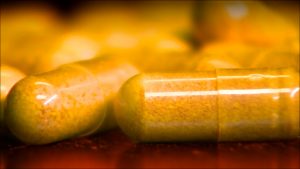Jan 12 2017
Curcumin Hype vs Reality
 A recent systematic review of the alleged health benefits of curcumin show that, yet again, hype based on “traditional use” is not a reliable guide.
A recent systematic review of the alleged health benefits of curcumin show that, yet again, hype based on “traditional use” is not a reliable guide.
Curcumin is a spice that makes up about 5% of turmeric, a yellow spice used in many curries. It is also a traditional herbal treatment. The health claims made for curcumin are numerous – WebMD has this entry:
Other preliminary lab studies suggest that curcumin or turmeric might protect against types of skin diseases, Alzheimer’s disease, colitis, stomach ulcers, and high cholesterol. Based on lab studies, turmeric and curcumin might also help treat upset stomach, scabies, diabetes, HIV, uveitis, and viral infections.
The systematic review had two main findings:
No double-blinded, placebo controlled clinical trial of curcumin has been successful. This manuscript reviews the essential medicinal chemistry of curcumin and provides evidence that curcumin is an unstable, reactive, nonbioavailable compound and, therefore, a highly improbable lead.
Let’s take the second point first, bioavailability. In order for a drug to be useful when taken orally it has to have adequate bioavailability. This means it needs to be relatively stable, it has to be absorbed in adequate amounts through the GI tract, and then it has to survive a first pass through the liver and be distributed in the body in such a way that it gets to its target tissue is sufficient concentration to have a clinical effect.
Any one of the steps could be a fatal flaw for a potential drug or compound. Most substances do not have all the properties necessary to be an effective treatment. Pharmaceutical companies spend a lot of time and resources studying the pharmacokinetics and pharmacodynamics of drug candidates, and often tweaking them in an attempt to give them the properties they would need to be an effective treatment.
Most herbs do not have these properties. They therefore fail as a therapeutic agent out of the gate. The authors of this review found that studies of curcumin show it does not have the overall bioavailability to be an effective treatment for anything.
Why, then, are there literally thousands of studies with curcumin or turmeric? It is because there is apparently a different set of rules for studying substances that have a traditional use and that are already being hyped to the public as having health benefits.
The usual science-based approach is to study a substance, as I described above, to see if it has the potential to be a therapeutic agent. It then goes through preclinical, animal, and then escalating human trials to determine its safety profile, and its net clinical effect. Most substances do not make it all the way through this chain of research to become approved drugs or proven therapeutics.
Substances deemed “natural” or with a traditional use or just marketed as having a traditional use do not follow this path. They are often marketed without any scientific evidence at all. When studied often there are preclinical trials to see what the substance does to cells in a petri dish. When you apply a chemical directly to cells, this bypasses all the concerns about bioavailability. Invariably stuff happens when you apply a chemical to cells. It is then tempting to speculate wildly from the changes in biochemical markers seen in the petri dish to possible clinical effects.
I need to note that it is notoriously difficult to predict clinical effects from pre-clinical markers. Even putting bioavailability aside, the body is just too complex to anticipate all outcomes. What such studies do, however, is give the illusion of being science-based to the traditional claims made for herbs and other treatments.
Often there are also preliminary human trials – small or unblinded trials, sometimes looking at subjective outcomes. Such studies have a proven massive false-positive bias. These preliminary studies often feed further hype about the alleged natural treatment, which is spread breathlessly and gullibly by the media.
Eventually such “natural” treatments may get to actual double blind clinical trials which are capable of determining if it actually works for any specific indication. Most of the time when studies progress to this level, the rigorous studies show that the substance does not work after all.
Curcumin is just the latest herb to fall into this pattern. It should be no surprise – the preclinical and preliminary studies are a horrible guide to actual clinical effects. So is traditional use, which is essentially just anecdotal evidence, subject to confirmation bias and placebo effects.
The story of curcumin also shows how easy it is to waste scientific resources chasing a lost cause. Chemical analysis of curcumin clearly indicated it was a poor therapeutic candidate due to fatally low bioavailability. This essentially means that all the clinical studies were a waste of time.
Some argue that it is still worthwhile to do the clinical studies in order to inform the public so that people can make better decisions about a product already in use. That is not what happens historically, however. First – most of the research, which is misleading, serves to feed the hype. The research is cherry-picked and presented without proper scientific context. Only when the research matures to a significant degree do we get some reliable conclusions.
Historically, when big and rigorous blinded clinical trials show that a product already in use does not work, this does have a negative impact on sales. However, this negative impact is temporary, and the next overhyped herb or natural treatment must moves up the line. The public never seems to learn the meta-lesson, that they should not believe any of the hype, that “natural” does not mean anything, and that herbs are poorly regulated and the industry cannot be trusted.






